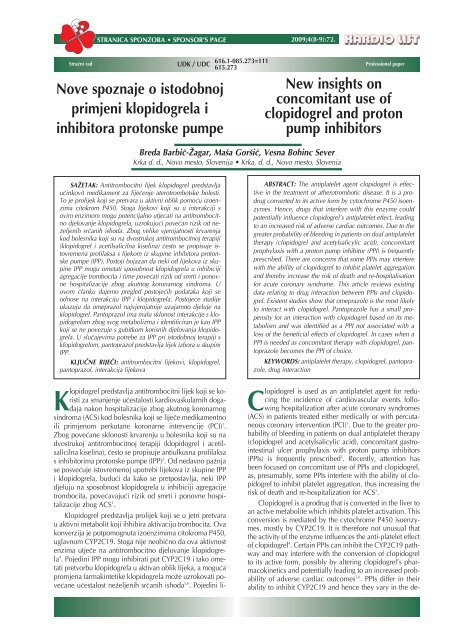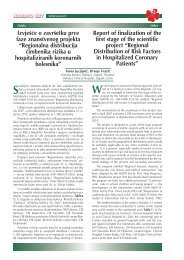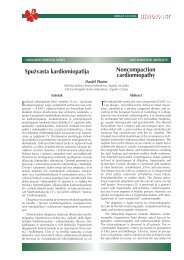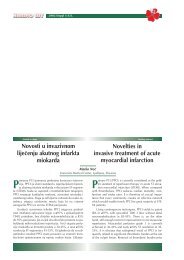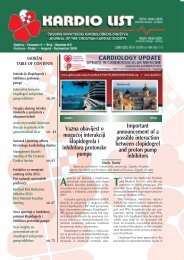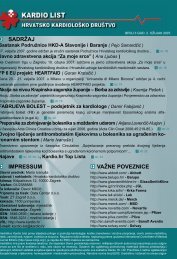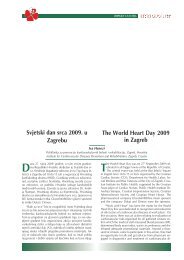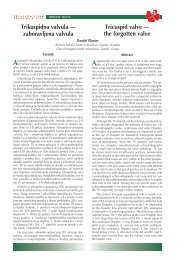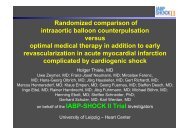udc 616.1 - Kardio.hr
udc 616.1 - Kardio.hr
udc 616.1 - Kardio.hr
Create successful ePaper yourself
Turn your PDF publications into a flip-book with our unique Google optimized e-Paper software.
STRANICA SPONZORA • SPONSOR’S PAGE<br />
2009;4(8-9):72.<br />
StruËni rad<br />
UDK / UDC <strong>616.1</strong>-085.273=111<br />
615.273<br />
Nove spoznaje o istodobnoj<br />
primjeni klopidogrela i<br />
inhibitora protonske pumpe<br />
Professional paper<br />
New insights on<br />
concomitant use of<br />
clopidogrel and proton<br />
pump inhibitors<br />
Breda BarbiË-Æagar, Maπa GorπiË, Vesna Bohinc Sever<br />
Krka d. d., Novo mesto, Slovenija • Krka, d. d., Novo mesto, Slovenia<br />
SAÆETAK: Antitrombocitni lijek klopidogrel predstavlja<br />
uËinkovit medikament za lijeËenje aterotrombotske bolesti.<br />
To je prolijek koji se pretvara u aktivni oblik pomoÊu izoenzima<br />
citokrom P450. Stoga lijekovi koji su u interakciji s<br />
ovim enzimom mogu potencijalno utjecati na antitrombocitno<br />
djelovanje klopidogrela, uzrokujuÊi poveÊan rizik od neæeljenih<br />
srËanih ishoda. Zbog velike vjerojatnosti krvarenja<br />
kod bolesnika koji su na dvostrukoj antitrombocitnoj terapiji<br />
(klopidogrel i acetilsalicilna kiselina) Ëesto se propisuje istovremena<br />
profilaksa s lijekom iz skupine inhibitora protonske<br />
pumpe (IPP). Postoji bojazan da neki od lijekova iz skupine<br />
IPP mogu ometati sposobnost klopidogrela u inhibiciji<br />
agregacije trombocita i time poveÊati rizik od smrti i ponovne<br />
hospitalizacije zbog akutnog koronarnog sindroma. U<br />
ovom Ëlanku dajemo pregled postojeÊih podataka koji se<br />
odnose na interakciju IPP i klopidogrela. PostojeÊe studije<br />
ukazuju da omeprazol najvjerojatnije uzajamno djeluje na<br />
klopidogrel. Pantoprazol ima malu sklonost interakcije s klopidogrelom<br />
zbog svog metabolizma i identificiran je kao IPP<br />
koji se ne povezuje s gubitkom korisnih djelovanja klopidogrela.<br />
U sluËajevima potrebe za IPP pri istodobnoj terapiji s<br />
klopidogrelom, pantoprazol predstavlja lijek izbora u skupini<br />
IPP.<br />
KLJU»NE RIJE»I: antitrombocitni lijekovi, klopidogrel,<br />
pantoprazol, interakcija lijekova<br />
Klopidogrel predstavlja antitrombocitni lijek koji se koristi<br />
za smanjenje uËestalosti kardiovaskularnih dogaappleaja<br />
nakon hospitalizacije zbog akutnog koronarnog<br />
sindroma (ACS) kod bolesnika koji se lijeËe medikamentno<br />
ili primjenom perkutane koronarne intervencije (PCI) 1 .<br />
Zbog poveÊane sklonosti krvarenju u bolesnika koji su na<br />
dvostrukoj antitrombocitnoj terapiji (klopidogrel i acetilsalicilna<br />
kiselina), Ëesto se propisuje antiulkusna profilaksa<br />
s inhibitorima protonske pumpe (IPP) 2 . Od nedavno paænja<br />
se posveÊuje istovremenoj upotrebi lijekova iz skupine IPP<br />
i klopidogrela, buduÊi da kako se pretpostavlja, neki IPP<br />
djeluju na sposobnost klopidogrela u inhibiciji agregacije<br />
trombocita, poveÊavajuÊi rizik od smrti i ponovne hospitalizacije<br />
zbog ACS 3 .<br />
Klopidogrel predstavlja prolijek koji se u jetri pretvara<br />
u aktivni metabolit koji ihhibira aktivaciju trombocita. Ova<br />
konverzija je potpomognuta izoenzimima citokroma P450,<br />
uglavnom CYP2C19. Stoga nije neobiËno da ova aktivnost<br />
enzima utjeËe na antitrombocitno djelovanje klopidogrela<br />
4 . Pojedini IPP mogu inhibirati put CYP2C19 i tako ometati<br />
pretvorbu klopidogrela u aktivan oblik lijeka, a moguÊa<br />
promjena farmakintetike klopidogrela moæe uzrokovati poveÊane<br />
uËestalost neæeljenih srËanih ishoda 5,6 . Pojedini li-<br />
ABSTRACT: The antiplatelet agent clopidogrel is effective<br />
in the treatment of atherotrombotic disease. It is a prodrug<br />
converted to its active form by cytoc<strong>hr</strong>ome P450 isoenzymes.<br />
Hence, drugs that interfere with this enzyme could<br />
potentially influence clopidogrel’s antiplatelet effect, leading<br />
to an increased risk of adverse cardiac outcomes. Due to the<br />
greater probability of bleeding in patients on dual antiplatelet<br />
therapy (clopidogrel and acetylsalicylic acid), concomitant<br />
prophylaxis with a proton pump inhibitor (PPI) is frequently<br />
prescribed. There are concerns that some PPIs may interfere<br />
with the ability of clopidogrel to inhibit platelet aggregation<br />
and thereby increase the risk of death and re-hospitalisation<br />
for acute coronary syndrome. This article reviews existing<br />
data relating to drug interaction between PPIs and clopidogrel.<br />
Existent studies show that omeprazole is the most likely<br />
to interact with clopidogrel. Pantoprazole has a small propensity<br />
for an interaction with clopidogrel based on its metabolism<br />
and was identified as a PPI not associated with a<br />
loss of the beneficial effects of clopidogrel. In cases when a<br />
PPI is needed as concomitant therapy with clopidogrel, pantoprazole<br />
becomes the PPI of choice.<br />
KEYWORDS: antiplatelet therapy, clopidogrel, pantoprazole,<br />
drug interaction<br />
Clopidogrel is used as an antiplatelet agent for reducing<br />
the incidence of cardiovascular events following<br />
hospitalization after acute coronary syndromes<br />
(ACS) in patients treated either medically or with percutaneous<br />
coronary intervention (PCI) 1 . Due to the greater probability<br />
of bleeding in patients on dual antiplatelet therapy<br />
(clopidogrel and acetylsalicylic acid), concomitant gastrointestinal<br />
ulcer prophylaxis with proton pump inhibitors<br />
(PPIs) is frequently prescribed 2 . Recently, attention has<br />
been focused on concomitant use of PPIs and clopidogrel,<br />
as, presumably, some PPIs interfere with the ability of clopidogrel<br />
to inhibit platelet aggregation, thus increasing the<br />
risk of death and re-hospitalization for ACS 3 .<br />
Clopidogrel is a prodrug that is converted in the liver to<br />
an active metabolite which inhibits platelet activation. This<br />
conversion is mediated by the cytoc<strong>hr</strong>ome P450 isoenzymes,<br />
mostly by CYP2C19. It is therefore not unusual that<br />
the activity of the enzyme influences the anti-platelet effect<br />
of clopidogrel 4 . Certain PPIs can inhibit the CYP2C19 pathway<br />
and may interfere with the conversion of clopidogrel<br />
to its active form, possibly by altering clopidogrel’s pharmacokinetics<br />
and potentially leading to an increased probability<br />
of adverse cardiac outcomes 5,6 . PPIs differ in their<br />
ability to inhibit CYP2C19 and hence they vary in the de-
2009;4(8-9):73.<br />
STRANICA SPONZORA • SPONSOR’S PAGE<br />
jekovi iz skupine IPP razlikuju se po svojoj moguÊnosti inhibiranja<br />
CYP2C19 pa stoga imaju i razliËit stupanj smanjenja<br />
antitrombocitnog djelovanja klopidogrela 6 . Izmeappleu<br />
svih IPP omeprazol ima najveÊu sklonost za CYP2C19, a<br />
pantoprazol ima najmanju sklonost za ovaj enzim 5 . Stoga<br />
se postavlja pitanje postoji li IPP koji ima prednost kod antiulkusne<br />
profilakse pri istodobnoj primjeni s klopidogrelom.<br />
Postoji razliËiti farmakoloπki i kliniËki dokazi o interakciji<br />
IPP i klopidogrela. Do danas su objavljene dvije velike<br />
epidemioloπke studije s potpunim rezultatima 1,5 , dok je nekoliko<br />
analiza dostupno samo u saæetku Ëime se onemoguÊava<br />
dubinska analiza rezultata 7 .<br />
Gillard i sur. 8 sugerirali su negativno djelovanje IPP na<br />
klopidogrel. U njihovoj studiji 140 bolesnika koji su se<br />
podvrgli implantaciji stenta lijeËeni su sedam dana omeprazolom<br />
ili placebom te je ocijenjena trombocitna funkcija<br />
vazodilatorno-stimulirajuÊim fosfoproteinom (VASP).<br />
Sedmog dana prosjeËni indeks reaktivnosti trombocita<br />
(PRI) bio je 39,8% (SD 15,4) za placebo grupu i 51,4% (SD<br />
16,4) za omeprazolsku grupu. U skupini lijeËenih omeprazolom<br />
postojao je veÊi broj ispitanika sa slabijim odgovorom<br />
na klopidogrel, πto ukazuje da je omeprazol znaËajno<br />
smanjio antitrombocitno djelovanje klopidogrela 8 .<br />
Siller-Matula i sur. 9 objavili su studiju u kojoj su ocjenjivali<br />
da li je ovo negativno djelovanje zapravo djelovanje<br />
klase. ProuËavali su djelovanje pantoprazola i esomeprazola<br />
na trombocitnu reaktivnost klopidogrela pri analizi<br />
VASP. Utvrdili su da nema razlike u PRI kod bolesnika na<br />
pantoprazolu (n = 152, PRI = 50%) ili esomeprazolu (n =<br />
74, PRI = 54%) u odnosu na bolesnike bez IPP (n = 74, PRI<br />
= 49%; P = 0.382). Za razliku od rezultata studije od Gillarda<br />
8 , kojom se dokazalo da omeprazol mijenja inhibiciju<br />
trombocita uzrokovanu klopidogrelom, utvrappleeno je da se<br />
trombocitna inhibicija ne mijenja ako se koristi pantoprazol<br />
ili esomeprazol.<br />
KliniËki znaËaj interakcije IPP i klopidogrela istraæivao<br />
je Juurlink 5 u studiji od 13.636 bolesnika koji primaju klopidogrel<br />
nakon akutnog infarkta miokarda. U primarnoj<br />
analizi upotreba IPP se povezuje s poviπenim rizikom od<br />
ponovnog infarkta (OR 1.2; CI: 1.03 — 1.57). Nije bilo<br />
moguÊe otkriti poviπeni rizik od ponovnog infarkta meappleu<br />
bolesnicima koji uzimaju pantoprazol. Istovremena terapija<br />
s IPP osim pantoprazola povezivala se s gubitkom korisnih<br />
djelovanja klopidogrela 5 .<br />
U retrospektivnoj studiji Ho i suradnika 1 8205 bolesnika<br />
s ACS koji su uzimali klopidogrel po otpustu iz bolnice,<br />
uporaba klopidogrela uz IPP povezivala se s rizikom od<br />
smrti ili ponovne hospitalizacije za ACS (OR 1.25; 95% CI<br />
1.11-1.41) u usporedbi s upotrebom klopidogrela bez IPPa.<br />
Kod ocjene pojedinaËnih lijekova iz skupine IPP, stalno<br />
povezivanje s poviπenim rizikom otkriveno je kod omeprazola<br />
(OR 1.24; 95% CI 1.08-1.41) i rabeprazola (OR 2.83;<br />
95% CI 1.96-4.09) 1 .<br />
Potrebne su studije za dobivanje dodatnih podatka radi<br />
boljeg razumijevanja i karakteriziranja utjecaja IPP na klopidogrel.<br />
Meappleutim, postojeÊa istraæivanja ukazuju da odreappleeni<br />
IPP mogu negativno djelovati na antitrombocitno<br />
djelovanje klopidogrela, iako ovo djelovanje ne mora biti<br />
djelovanje klase. Smanjenje antitrombocitne aktivnosti je<br />
uglavnom vidljivo pri istodobnoj uporabi omeprazola. Ostali<br />
IPP, kao πto rabeprazol i lanzoprazol takoappleer mogu utgree<br />
to which they reduce the antiplatelet activity of clopidogrel<br />
6 . Among the PPIs, omeprazole has the greatest affinity<br />
for CYP2C19 and pantoprazole has the lowest affinity<br />
for this enzyme 5 . Thus, a question arises if there is a preferred<br />
PPI that should be used for gastrointestinal (GI) ulcer<br />
prophylaxis in combination with clopidogrel.<br />
There exists various pharmacological and clinical evidence<br />
of interaction between PPIs and clopidogrel. To date,<br />
two large epidemiologic studies have been published<br />
with full results [1, 5], while several analyses are available<br />
only in abstract form, which limits in-depth analysis of the<br />
findings 7 .<br />
Gillard et al. 8 suggested a negative impact of PPIs on<br />
clopidogrel. In their study, 140 patients undergoing coronary<br />
stent replacement received omeprazole or placebo for<br />
seven days and platelet function assessment by vasodilator-stimulated<br />
phosphoprotein (VASP) was performed. On<br />
day 7, the mean PRI (platelet reactivity index) was 39.8%<br />
(SD 15.4) for the placebo group and 51.4% (SD 16.4) for<br />
the omeprazole group. There was a higher number of poor<br />
clopidogrel responders in the omeprazole group, indicating<br />
that omeprazole significantly decreased the antiplatelet<br />
effect of clopidogrel 8 .<br />
Siller-Matula et al. 9 published a study in which they assessed<br />
whether this negative effect is a class effect. They<br />
studied the pantoprazole and esomeprazole effects on clopidogrel<br />
platelet reactivity with the VASP assay. They established<br />
that there was no difference in the PRI in patients<br />
on pantoprazole (n = 152, PRI = 50%) or esomeprazole (n<br />
= 74, PRI = 54%) compared with patients without a PPI (n<br />
= 74, PRI = 49%; P = 0.382). In contrast to the study results<br />
by Gillard et al. 8 , showing that omeprazole alters platelet<br />
inhibition by clopidogrel, they found out that platelet inhibition<br />
was not altered when pantoprazole or esomeprazole<br />
were used.<br />
The clinical significance of the interaction between<br />
PPIs and clopidogrel was investigated by Juurlink 5 in a<br />
case-control study of 13,636 patients receiving clopidogrel<br />
after acute myocardial infarction. In the primary analysis,<br />
the use of PPIs was found to be associated with an increased<br />
risk of reinfarction (odds ratio (OR): 1.2, confidence interval<br />
(CI): 1.03 — 1.57). There was no detectable increase<br />
in the risk of reinfarction among patients taking pantoprazole.<br />
Concomitant therapy with PPIs other than pantoprazole<br />
was associated with a loss of the beneficial effects of<br />
clopidogrel 5 .<br />
In a retrospective cohort study by Ho et al. 1 of 8,205<br />
patients with ACS taking clopidogrel after discharge from<br />
the hospital, the use of clopidogrel plus PPI was associated<br />
with an increased risk of death or re-hospitalization for<br />
ACS (adjusted OR: 1.25; 95% CI: 1.11-1.41) compared<br />
with the use of clopidogrel without a PPI. When evaluating<br />
individual PPI agents, a consistent association with an increased<br />
risk was found with omeprazole (OR: 1.24; 95%<br />
CI: 1.08-1.41) and rabeprazole (OR: 2.83; 95% CI: 1.96-<br />
4.09) 1 .<br />
Studies to obtain additional information to better understand<br />
and characterize the effect of PPIs on clopidogrel<br />
have to be done. However, the available research suggests<br />
that certain PPIs may have a negative effect on clopidogrel<br />
antiplatelet activity although this effect may not be a class<br />
effect. A decrease of antiplatelet activity is seen primarily
STRANICA SPONZORA • SPONSOR’S PAGE<br />
jecati na klopidogrel, dok su pantoprazol i esomeprazol<br />
oËito neutralni 7 . Meappleu lijekovima iz skupine IPP, pantoprazol<br />
predstavlja najslabiji inhibitor CYPC219 te je malo vjerojatno<br />
da Êe postojati interakcija s klopidogrelom. Kao zakljuËak,<br />
postojeÊi podaci pokazuju da bi se u situacijama<br />
u kojima se indiciraju i klopidogrel i IPP, trebalo primjenjivati<br />
pantoprazol buduÊi da Êe tada interakcija s klopidogrelom<br />
biti najmanje uËestala 6,7 .<br />
Krka ima u svom portfelju klopidogrel (Zyllt ® ) i tri IPP:<br />
omeprazol (Ultop ® ), lansoprazol (Lanzul ® ) i pantoprazol<br />
(Nolpaza ® ). Krkin klopidogrel se na meappleunarodnom træiπtu<br />
nalazi veÊ Ëetiri godine. To je vodeÊi generiËki klopidogrel<br />
u srednjoj, istoËnoj i jugoistoËnoj Europi. Njegova uËinkovitost<br />
i sigurnost su dokazani u studijama o postautorizacijskoj<br />
sigurnosti i uËinkovitosti te u vlastitim kliniËkim studijama<br />
10 . Krkin pantoprazol je bio meappleu prvim generiËkim<br />
pantoprazolima koji su proizvedeni u Europi i odobren je<br />
u 26 dræava. Njegova jedinstvena formula je predana za<br />
zaπtitu patenta i godiπnje se proizvode viπe od 200 milijuna<br />
tableta 11 .<br />
Received: 22 nd Jul 2009<br />
E-mail: breda.zagar@krka.biz<br />
Literature<br />
2009;4(8-9):74.<br />
with the concomitant use of omeprazole. Other PPIs, such<br />
as rabeprazole and lansoprazole, may also influence clopidogrel,<br />
while pantoprazole and esomeprazole appear to be<br />
neutral 7 . Among all PPIs, pantoprazole is the weakest inhibitor<br />
of CYPC219, making an interaction with clopidogrel<br />
very unlikely. In conclusion, the existing data show that in<br />
situations in which both clopidogrel and a PPI are indicated,<br />
pantoprazole should be used, since it is the PPI least<br />
likely to interact with clopidogrel 7 .<br />
Krka has in its portfolio clopidogrel (Zyllt ® ) and t<strong>hr</strong>ee<br />
PPIs: omeprazole (Ultop ® ), lansoprazole (Lanzul ® ) and pantoprazole<br />
(Nolpaza ® ). Krka’s clopidogrel has been present<br />
on the international market for four years. It is the leading<br />
generic clopidogrel in Central, Eastern and Southeastern<br />
Europe. Its efficacy and safety have been proven in postauthorisation<br />
safety and efficacy studies and own clinical<br />
studies 10 . Krka’s pantoprazole was among the first generic<br />
pantoprazoles produced in Europe and it is approved in 26<br />
countries. Its unique formulation is filed for patent protection<br />
and more than 200 millions tablets are produced per<br />
year 11 .<br />
1. Ho PM, Maddox TM, Wang L, Fihn SD, Jesse RL, Peterson ED, et al. Risk of adverse outcomes associated with concomitant use of clopidogrel<br />
and proton pump inhibitors following acute coronary syndrome. JAMA. 2009;301:937-44.<br />
2. Bhatt DL, Scheiman J, Abraham NS, Antman EM, Chan FK, Furberg CD, et al. ACCF/ACG/AHA 2008 expert consensus document on reducing<br />
the gastrointestinal risks of antiplatelet therapy and NSAID use: a report of the American College of Cardiology Foundation Task Force on Clinical Expert<br />
Consensus Documents. Circulation. 2008;118:1894-909.<br />
3. Gurbel PA, Lau WC, Tantry US. Omeprazole: a possible new candidate influencing the antiplatelet effect of clopidogrel. J Am Coll Cardiol.<br />
2008;51:261-3.<br />
4. Kim KA, Park PW, Hong SJ, Park JY. The effect of CYP2C19 polymorphism on the pharmacokinetics and pharmacodynamics of clopidogrel: a<br />
possible mechanism for clopidogrel resistance. Clin Pharmacol Ther. 2008;84:236-42.<br />
5. Juurlink DN, Gomes T, Ko DT, Szmitko PE, Austin PC, Tu JV, et al. A population-based study of the drug interaction between proton pump inhibitors<br />
and clopidogrel. CMAJ. 2009:180;713-8.<br />
6. Khalique SC, Cheng-Lai A. Drug interaction between clopidogrel and proton pump inhibitors. Cardiol Rev. 2009;17:198-200.<br />
7. Norgard NB, Mathews KD, Wall GC. Drug-drug interaction between clopidogrel and the proton pump inhibitors. Ann Pharmacother.<br />
2009;43:1266-74.<br />
8. Gilard M, Arnaud B, Cornily JC, Le Gal G, Lacut K, Le Calvez G, et al. Influence of omeprazole on the antiplatelet action of clopidogrel associated<br />
with aspirin: the randomized, double-blind OCLA (Omeprazole CLopidogrel Aspirin) study. J Am Coll Cardiol. 2008;51:256-60.<br />
9. Siller-Matula JM, Spiel AO, Lang IM, Kreiner G, C<strong>hr</strong>ist G, Jilma B. Effects of pantoprazole and esomeprazole on platelet inhibition by clopidogrel.<br />
Am Heart J. 2009;157:148.e1-148.e5.<br />
10. Grinstein YI, Savchenko EA, Filonenko IV, Grinstein IYu, Savchenko AA. Zyllt in coronary atherosclerosis patients after coronary artery bypass<br />
graft surgery. Preliminary results of an open, randomized, comparative ZEUS Study. <strong>Kardio</strong>vaskularnaya terapija i profilaktika 2008;7(6):1-7.<br />
11. Data on file. Krka d.d., Novo mesto, Slovenia, 2009.


